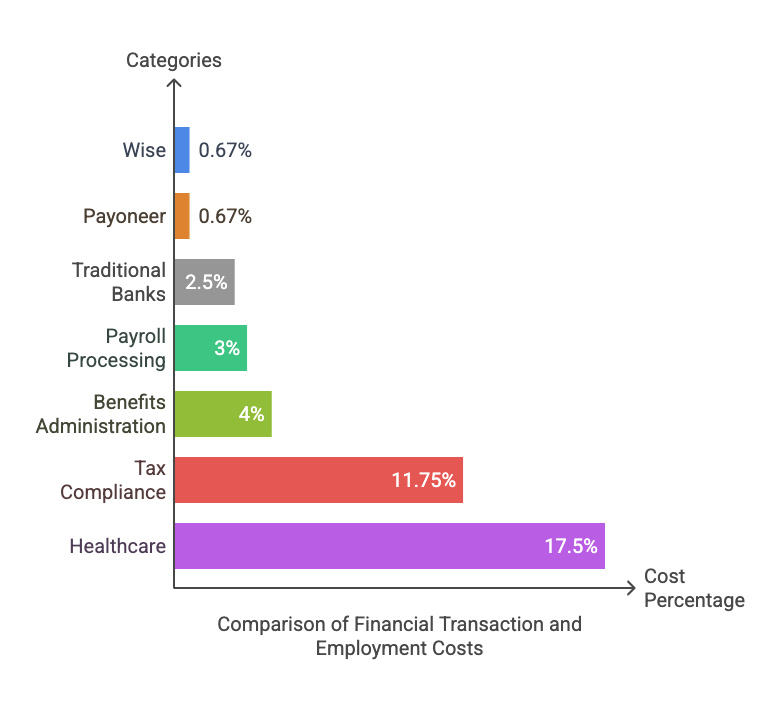Business owners outsource primarily to access global talent, save time, and optimize operations. Outsourcing allows companies to tap into a diverse pool of specialized skills worldwide, enhancing innovation and creativity. It also offers significant cost savings by leveraging lower labor costs in different regions, enabling businesses to focus on core competencies and scale operations efficiently.
However, while outsourcing provides these benefits, it also presents challenges such as maintaining quality control and overcoming communication barriers. Ensuring consistent quality across outsourced tasks requires robust monitoring systems, and differences in language, time zones, and cultural practices can hinder effective collaboration. Despite these concerns, with careful strategies for outsourcing, tapping into the global recruitment can be a powerful tool for business growth and sustainability.
With Go Carpathian, you can outsource highly professional talents from Eastern Europe, South Africa, and Latin America. Outsourcing in these regions allows you to reduce hiring costs while leveraging the expertise of the local pre-vetted talents.
In this article, we will guide you through the 4 strategies for outsourcing, including identifying the right tasks to outsource, selecting the best outsourcing partners, streamlining payments, and building strong communication channels.
The Benefits of Outsourcing for Your Business
Understanding the advantages is one of the first strategies for outsourcing success. Outsourcing offers numerous benefits for business owners, allowing them to optimize operations and focus on growth. Key advantages include:
- Cost Savings: Outsourcing reduces expenses by leveraging lower labor costs in other regions and eliminating the need for investments in infrastructure, technology, and training. Businesses can save up to 60% on operational costs by outsourcing tasks to countries with a lower cost of living.
- Access to Expertise: It enables businesses to tap into a global talent pool, gaining access to specialized skills and advanced technologies that may not be available in-house. This expertise often leads to higher-quality outputs and innovative solutions.
- Increased Efficiency and Productivity: Outsourcing partners bring experience and streamlined processes, allowing businesses to complete tasks more efficiently while focusing their internal resources on core competencies.
- Scalability and Flexibility: Businesses can scale operations up or down based on demand without the long-term commitment of hiring permanent staff, making it easier to adapt to market changes.
- Time Savings: By delegating time-consuming tasks, business owners can focus on strategic activities, improving overall time management and fostering growth opportunities.
- Improved Customer Satisfaction: Faster delivery of high-quality services through outsourcing can enhance customer experiences and satisfaction, contributing to long-term success.
Strategy 1 – Identify the Right Tasks to Outsource
Business owners are always juggling a dozen priorities, and something’s got to give. That’s where outsourcing comes in. But the real question is, how to decide which tasks to outsource?
One of the top strategies for outsourcing is picking tasks that maximize your impact without draining your energy. Start by looking at the repetitive, time-sucking tasks that you don’t like doing. Think data entry, scheduling, or posting to social media. These are the kinds of tasks that don’t require special talent. They just need to get done. Handing them off frees you up for the big-picture stuff, like closing deals or planning your next campaign.
On the other hand, keep the high-stakes, strategic work close. Things like setting your company’s vision or negotiating with key clients? That’s your priority. To figure out what’s outsourceable, ask yourself: Is this task standardized? Can someone follow a clear process to do it? Does it need constant oversight? If the answer is yes, yes, and no, it’s a prime candidate. For example, managing customer inquiries with a script works great outsourced, but crafting your brand’s voice probably doesn’t.
Here’s a quick tip: Listen to your team. Spend a week tracking where your and their hours go. Those bottlenecks are your outsourcing goldmines. Maybe it’s chasing invoices or formatting reports. Whatever it is, pinpointing these tasks is the first step to working smarter, not harder. The goal isn’t to offload everything. It’s to free up your time for what moves the needle. Get this right, and you’ll wonder why you didn’t start sooner. That’s the power of smart strategies for outsourcing: they put you back in control of your day.
Strategy 2 – Select the Best Outsourcing Partners
You’ve decided what to outsource. The next step is picking the right partner who can help you put smart strategies for outsourcing in motion.
Start by weighing your options: platforms like Upwork give you speed and variety, while agencies offer vetted, curated hires.
Platforms are great for one-off projects, for example, a quick design project. The reason for this is that platforms like Upwork provide quick access to a global pool of freelancers who specialize in diverse skills, such as web development, graphic design, or content creation. Businesses benefit from the flexibility to hire talent on demand without long-term commitments, making it cost-effective and efficient for short-term needs.
But if you need a steady virtual assistant or a marketing pro, a professional recruitment agency like Go Carpathian can help you find the best international talent. As an experienced outsourcing service provider, Go Carpathian can connect business owners to previously vetted candidates that match their specific needs.
Pre-vetting candidates is especially important because it saves business owners time and ensures that they only talk to people who understand their work. Finding the right hires can be an overwhelming process and hiring a professional agency can help you get in touch with the right people.
Strategy 3 – Streamline Payment and Compliance
Many business owners dread international payments because they are afraid of extra steps that might be too complicated and extra fees that nobody wants.
We have good news: if you can use PayPal, you can manage international payments. Start with tools built for global hires: Payoneer or Wise are your go-tos.
Payoneer and Wine both shine for international transfers, cutting costs on exchange rates when you’re paying overseas talent. If you are still unsure about the hidden costs, here’s a breakdown of costs and a comparison of international and domestic employment costs:
- Wise: 0.33-1% per transfer
- Payoneer: Similar rates
- Traditional banks: 2-3%
Compared that to domestic employment costs:
- Payroll Processing: 2-4% of payroll expenses, including subscription fees, setup costs, and per-employee charges).
- Benefits Administration: 3-5% of payroll expenses
- Tax Compliance: managing federal payroll taxes (7.65% for FICA), federal unemployment taxes (0.6% after credits), and state unemployment taxes (typically 2.7-6.2%), totaling around 11.75% of payroll expenses.
- Healthcare: 15-20% of an employee’s salary
International payment platforms like Wise and Payoneer offer lower fees compared to traditional banks making them cost-effective for paying overseas team members.
A Step-By-Step to Setting a Wise Account
Here’s a step-by-step guide to setting up a Wise account for international payments:
Step 1: Download the Wise App or Visit the Website
- Option 1: Download the Wise app from the App Store (for iOS) or Google Play Store (for Android).
- Option 2: Visit the Wise website on your desktop or mobile browser.
Step 2: Register for a Wise Account
- Click on the “Register” button.
- Create your account using your email, Apple ID, Google ID, or Facebook details.
- Set a secure password for your account.
Step 3: Add Personal Information
- Follow the on-screen prompts to add your personal details:
- Full name
- Date of birth
- Contact number
- Residential address
Step 4: Verify Your Identity
- You will need to verify your identity to comply with legal requirements.
- Upload images of your ID documents (e.g., passport, national ID card, photo driver’s license).
- Take a selfie holding your ID for verification.
- If you have a US-issued SSN or ITIN, you can enter this during the verification process.
Step 5: Set Up Your Account
- Once verified, you can top up your account or set up your first transfer.
- You can also order a Wise Multi-Currency Card for international transactions.
Step 6: Create Local Account Details for Receiving Payments
- If you want to receive international payments, you can set up local account details in eligible currencies (e.g., USD, EUR, GBP).
- To do this:
- Log into your Wise account.
- Find the balance you need and click on “Get account details.”
- Follow the prompts to set up your local account details.
Step 7: Use Your Wise Account for International Payments
- You can now use your Wise account to send money to over 160 countries.
- To send money:
- Go to the “Send” section.
- Choose or add a recipient.
- Enter the amount you want to transfer.
- Choose your payment method.
- Review and confirm your transaction.
Step 8: Manage Your Account
- You can hold and exchange over 40 currencies using mid-market exchange rates.
- Monitor your transactions and account balances through the Wise app or website.
Now that we covered international payroll, we can move to compliance. Compliance doesn’t have to be a nightmare either. Most outsourced workers are contractors, not employees, so you skip payroll taxes and benefits. Make sure your international hires agree to this upfront and ask them to invoice you as a contracto. A quick consult with a legal expert can whip up a basic contract covering work and payment terms, safeguarding both sides. It’s a small step that avoids big problems.
Bonus Invoicing Tips
Use invoicing software like QuickBooks or Wave. It tracks payments, stores records, and makes tax time painless. For example, you can set a regular cadence on a monthly basis and automate transfers through Payoneer or Wise where possible. Sure, international payments might involve minor fees or currency shifts, but they’re still lower compared to local salaries.
Strategy 4 – Build Strong Communication Channels
Another big fear that business owners have when it comes to outsourcing is not being able to keep everyone on the same page when it comes to work. One of the best strategies for outsourcing is setting up solid communication channels that work like clockwork.
Here are key steps to establish effective communication:
1. Use Reliable Communication Tools
Employ a mix of tools for different purposes, such as video conferencing (Zoom, Google Meet), instant messaging (Slack), and email for formal updates. Project management software like Trello or Asana can help track tasks and deadlines.
2. Establish a Communication Framework
Define clear rules for communication, including the frequency of meetings, preferred channels, and reporting formats. Set fixed schedules for updates and ensure all team members adhere to them.
3. Bridge Time Zone Differences
Account for time zone disparities by identifying overlapping working hours. If there are minimal overlaps, negotiate extra working hours for critical real-time communication.
4. Share Knowledge and Documentation
Provide offshore teams with access to detailed project documentation, guidelines, workflows, and technical resources. This minimizes misunderstandings and ensures clarity in expectations.
5. Encourage Regular and Transparent Communication
Schedule consistent check-ins, progress updates, and feedback sessions to keep everyone aligned. Foster a collaborative environment where team members feel comfortable sharing challenges or ideas openly.
6. Address Cultural and Language Barriers
Be mindful of cultural differences and adapt your communication style accordingly. Use simple language to avoid jargon or misinterpretation, and consider hiring bilingual team members or using translation services if necessary.
7. Document Communications
Maintain written records of important discussions, decisions, and updates to ensure clarity and accountability. This is particularly useful for asynchronous communication or resolving disputes later.
8. Reevaluate Communication Strategies Regularly
Periodically review your communication methods during retrospectives or project evaluations to identify areas for improvement and address emerging challenges.
Need a Partner for Outsourcing?
Some of the top strategies for outsourcing include identify the right tasks, selecting the best partners, streamlining payments and compliance, and building strong communication channels.
These steps can save you money and they give you flexibility to scale up or down without breaking a sweat. These strategies will let you focus on what you do best, whether that’s closing deals or dreaming up the next big thing. Outsourcing isn’t just a cost-cut, it’s a power move when you use these strategies for outsourcing right.
Need a partner to help you apply these strategies? Go Carpathian is the most reliable partner for international recruitment. Schedule a Discovery Call to learn more about finding the best international hires in Eastern Europe, Latin America, and South Africa!






